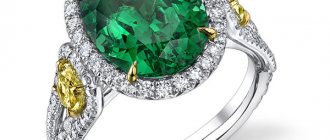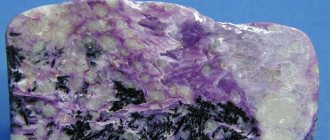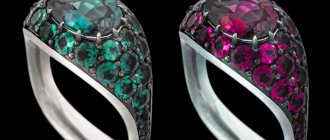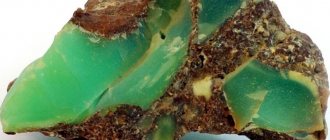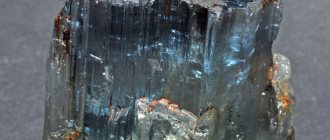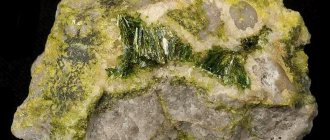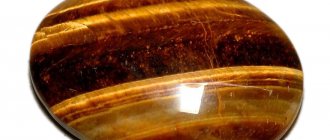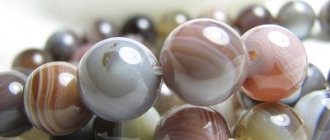Hessonite is a ferruginous variant of grossular (a mineral from the garnet group). It is not for nothing that it is called a chameleon stone: at different times of the day, under different lighting, from one angle or another, it changes color from orange to brown, casting purple, violet, lilac and chocolate shades.
Hessonite jewelry is especially charming because of this. The mineral is in demand in esotericism, folk medicine, and jewelry.
History and origin
The name of the stone reflects its properties. From the ancient Greek “hesson” is translated as “weakest”. The first jewelry made of hessonite appeared in ancient times. The Scythians, Greeks and Romans used amulets, talismans and crafts made from this stone. Later, kitchen utensils were often inlaid with hessonite. A few centuries ago, the warm-colored mineral was widely used to decorate books and icons.
Pebbles – Hessonite
Then interest in this stone faded for some time, resuming during the exploration of the Indian Ocean islands. From there they brought spices, tea and stones of a warm cinnamon color. For its resemblance to this spice, the mineral was called “cinnamon stone”. Today, the demand for high-quality hessonite is growing: this stone is beautiful and unusual.
Deposits[edit]
Grossular occurs in contacting metamorphosed limestones with vesuvianite, diopside, wollastonite and wernerite.
A very popular variety of gem garnets is the fine green Grossular garnet from Kenya and Tanzania, called tsavorite. This garnet was discovered in the 1960s in the Tsavo region of Kenya, from which the gem takes its name.
Viluit
is a variety of grossular that is not a recognized mineral species.
[5] It is usually olive green in color, but is sometimes brownish or reddish, which is caused by impurities in the crystal. Viluite has been found to be related to and similar in appearance to vesuvianite, and there is confusion in terminology as viluite
has long been used as a synonym for viluite, a sorosilicate of the vesuvianite group. This confusion in nomenclature dates back to James Dwight Dana. [6] It originates from the Vilyui River area in Siberia.
Grossular is known by many other names, as well as some misnomers; [7] colophonitis
- large granules of garnet, [8]
ernite
,
gooseberry garnet
- light green and translucent, [9]
olintholite
/
olitolite
,
romanzovite
and
tellemarkite
.
Misnomers include [2] South African jade
,
garnet jade
,
Transvaal jade,
and
African jade
.
Physical properties
Hessonite is a complex silicate of aluminum, iron and other elements. Interspersed with apatites and zircons give the stone a granular structure.
| Property | Description |
| Formula | Ca3Al2(SiO4)3 |
| Hardness | 7 — 7,5 |
| Density | 6.5 - 8 g/cm³ |
| Shine | Glass |
| Structure | Grainy |
| Fragility | fragile |
| Transparency | When processed it is transparent |
| Color | Orange, honey yellow, purple red |
Physico-chemical characteristics
According to the chemical classification, the mineral hessonite is classified as a carbonate. Its formula, composition and origin are similar to its “parent” pomegranate.
| Chemical formula | Ca3Al2[SiO4]3 |
| Selection form | dodecahedrons or trapezohedrons; there are twins of fusion and germination, grains of irregular shape, dense and massive aggregates |
| Color | orange, red, red-orange, brown |
| Transparency | transparent translucent |
| Hardness | 6,5 7 |
| origin of name | from the Greek word heason - weak, because. The hardness and density of hessonite is lower than that of other garnets |
Varieties
This type of grant is one of a kind. But thanks to the wide palette of shades, hessonite has many names indicating its properties:
- Eastern (Ceylon) hyacinth - the name indicates an external similarity with a mineral such as hyacinth (a reddish-brown variety of zircon).
- False hyacinth also indicates the similarity of two minerals.
- Colophonite is one of the outdated names, almost out of use today.
- Olintholite is another outdated synonym, used in scientific literature and reference books, mainly giving the designation to specimens of a yellow hue.
- Cinnamon Stone/Cinnamon Stone is a term used to describe stones that have a warm, spice-like hue.
Also read: Rhodochrosite – a stone of tenderness and fidelity
Links[edit]
- ^ abcdefghij GIA Gem Reference Guide
; Gemological Institute of America; 1995; ISBN 0-87311-019-6 - ^ ab Grossular The Mineral and Gemstone Kingdom, accessed online January 25, 2007.
- International Mineralogical Association (1971). "International Mineralogical Association: Commission on New Minerals and Mineral Names" (PDF). Mineralogical Journal
.
38
: 102–105. DOI: 10.1180/minmag.1971.038.293.14. - "Cinnamon Stone". Encyclopedia Britannica
.
6
(11th ed.). 1911. p. 376. - Viluite Mindat Database
- James Dwight Dunn's system of mineralogy. Descriptive Mineralogy James Dwight Dana, Edward Salisbury Dana, 1892, pp. 479-80
- Grossular mineral base Mindat, accessed January 25, 2007
- ↑
Colophonite The Free Dictionary, accessed online January 25, 2007. - Gooseberry Pomegranate WordWeb Internet
- "Emblems of Vermont". State of Vermont. Archived from the original on 2009-10-29. Retrieved November 12, 2009.
Medicinal properties
The presence of healing properties of the mineral is facilitated by its origin, ferromagnetic characteristics, and spectral absorption lines. Its properties are similar to pomegranate.
IMPORTANT! To achieve maximum benefits, it is recommended to wear products with the stone on parts of the body that require healing or are closely related to the corresponding internal organs.
- To optimize the functioning of the digestive system, wear a silver ring with yellow hessonite on the ring finger of your right hand.
- Decoration on the neck and chest - a necklace, choker, pendant - helps to cope with inflammatory processes in the throat and normalize the functioning of the upper respiratory tract. Recommended for sore throat, bronchitis, tracheitis and pneumonia.
- A jewelry bracelet on your right hand will help cope with allergies, digestive problems and constipation. As a result, the skin condition is normalized, you will forget about rashes and acne.
- Wearing a brooch with a mineral will alleviate asthma and strengthen the immune system.
Where is it used?
Areas of application of hessonite - jewelry and decor:
- The stone is fragile and not easy to cut, but the craftsmen do not miss the opportunity to work with it. Inserts for rings, earrings, pendants, links of beads, bracelets, and necklaces are machined.
- The second important area is decor. Hessonite is used to decorate icons, church and secular paraphernalia.
- Paintings are “painted” with crumbs of red-orange-cinnamon tones.
Ring with hessonite
Standard hessonite setting - silver, gold, platinum. They combine aesthetically, simultaneously enhancing the magic and healing capabilities of the stone.
Magic properties
This stone of reconciliation and justice, it helps strengthen family relationships. Jewelry is not recommended for liars and traitors.
The soft energy of this stone will give the owner comfort, a friendly and peaceful mood. A hessonite talisman will protect a person from impulsive, rash actions and help get rid of illusions and vain dreams.
Also read: Carnelian - the meaning of the stone for a person
The stone helps irritable and aggressive people cope with their emotions, regain self-control and a sense of harmony with themselves. In addition, the patronage of hessonite makes a person more attractive in the eyes of members of the opposite sex.
THIS IS INTERESTING! In Indian mythology, yellow gems were associated with the nails of the god Val. Hessonite was considered a stone that promotes creativity and gives inspiration.
Hessonite forms an aura of peace and benevolence around a person, gently eliminating negative emotions from the soul. In a large company, the owner of this stone is easy to notice: he behaves openly, does not keep his own experiences to himself, and is calm.
Combinations with other stones
Hessonite, like Vesuvian, is unpretentious in combination with other stones. The most favorable combination of stones must be selected individually. Beautiful products are obtained from the combination of Hessonite:
- ruby;
- sapphire;
- cornelian;
- amber;
- opal;
- Tiger's Eye;
- tourmaline;
- zircon.
The stones must be combined in color and physical properties, so that one does not damage the other. Hessonite is not recommended to be combined with stones with a hardness on the Mohs scale of more than 6: quartz, topaz, diamond, agate, jadeite, aventurine, rock crystal, emerald.
How to distinguish from a fake
Hessonite can be confused with garnet, as some specimens of the stone have a similar color. To distinguish it from a fake, you need to illuminate the stone through different lighting devices:
- in the sun's rays;
- in room conditions;
- under a fluorescent lamp.
The stone will vary greatly in shades from orange to brown. The stone is quite hard, so you need to check it with a special marker, which is always available in jewelry stores. Hessonite can be scratched by glass or a sharp object only if force is used, otherwise it is a fake.
Stone care
Hessonite is a hard and brittle stone, so it is important to protect it from thermal and physical influences: from falls, impacts, heat, acid. Such actions can deform the stone: chip, crack, become cloudy, and stains appear.
Hessonite products should be stored wrapped in soft cloth or a special jewelry box.
Easy to clean with a soft fleece, fiber, flannel cloth or rinse in soapy water. You can add shine to the stone using woolen fabric.
Hessonite is a magical stone; it reduces the negative qualities of its owner and increases the positive ones. It may dim or burn its owner if the person is plotting criminal or unjust actions against others.
Jewelry with mineral
The variety of shades and interesting properties of the stone attract jewelers. There are a variety of jewelry with the mineral: rings, necklaces, bracelets, brooches, earrings or rings.
Stone rings
The magical properties of hessonite contribute to the widespread use of amulets and talismans made from this stone. For a favorable atmosphere in the house, you can purchase an interior item inlaid with gems, for example, a box, an elegant figurine or a vase.
Decoration and household use
Jewelers pay attention to specimens that do not have defects: dullness, stains. Because it is very difficult to make products from it. When processing stone, it can often be damaged or deformed due to overheating, which will reduce its value. Hessonite products are in great demand in the form of jewelry, talismans, amulets and figurines due to their qualities.
The most favorable setting for Hessonite is considered to be: gold, copper, platinum. These metals can increase the energetic impact of the stone.
How to distinguish a fake?
Hessonite is an inexpensive semi-precious stone , but despite its affordable price, it can be counterfeited. Imitations of hessonite are often created from painted glass. To distinguish a genuine stone when purchasing, it is important to know some features:
- When examining a fake through a magnifying glass, you can see air bubbles inside.
- A genuine stone retains coolness for a long time, while an imitation stone quickly absorbs heat from the hand.
- The strength of hessonite is higher than that of glass, so the needle will not leave a mark on the original stone.
IMPORTANT! When purchasing, give preference to large jewelry chains with a good reputation. In such stores, customers are offered high-quality goods with real gems. Stones for the collection can be purchased at an auction or exhibition.
Hessonite
Sri Lankan garnets seem to “duplicate” more expensive stones. Here on the island they know not only the “Ceylon ruby” - almandine. Another rare red-orange stone has its own “double” - hyacinth, a brightly sparkling noble zircon.
Red-orange Ceylon garnet hessonite is indistinguishable in color from hyacinth
.
It got its name from the Greek word “esson” - low (its hardness is lower than the hardness of hyacinth). But it has its own personal advantages, primarily its size
.
Hessonites often reach 3 - 4 cm (which is never the case with zircon hyacinths!). And the area of possible cutting is a very important quality; it greatly affects the cost of the stone.
Hessonite also has one more original property : from a distance, its orange color is perceived as distinctly red, and if you bring it close to your eyes, it is perceived as honey-yellow.
The color of hessonite is also good because under artificial lighting it not only does not fade, but becomes even brighter and fresher
.
In terms of shine and play, hessonite is sharply inferior to its more noble counterpart: hyacinth sparkles and plays like a diamond, while hessonite is duller, without play, sometimes somehow resinous.
Among the garnets of Sri Lanka, there are yellow, almost transparent garnets, quite similar to melted candies, they are called “canel” - candy
. But if we talk about hessonites, it is worth remembering the beautiful hessonite brushes from Switzerland, from St. Gotthard, and especially about the spectacular druses of bright orange hessonite from the Ala River valley (Northern Italy, Piedmont), formed in cracks cutting serpentine rocks. The bright, rowan-like berries of hessonite garnet are accompanied here by dark green chlorite and light green transparent prismatic crystals of pyroxene diopside. Very similar druzes are also found here in the Urals, in the Akhmatov mine.
How to wear and care instructions
An interesting feature of hessonite is the fact that under electric lighting it becomes even brighter than under natural light. Therefore, jewelry made from this mineral will be an excellent addition to an evening look for going to the theater, restaurant or social event.
Also read: Wollastonite - a talisman against the evil eye and black magic
Hessonites should be stored in a soft cloth wrapper separately from other stones and jewelry. The stone is easy to care for: it can be cleaned with running water or soapy water, and then wiped with a clean soft cloth.
Spessartine
Pale pink, as they say, “the color of salmon,” spessartine is a garnet of granite pegmatites (tangerine garnet).
This is a manganese-aluminum garnet, and it is manganese that colors it, like all other minerals it contains, pink. If there is a lot of manganese in the mineral (more than 40%), then spessartine takes on a blood-red color. More often, its color is dominated by a yellow tint. Spessartine was found in the vicinity of the town of Spessart in Bavaria.
This pomegranate does not like the sun and fresh air, otherwise it will crack and crumble to dust. True, the stone also has durable jewelry options.
In addition to the characteristic faceted balls, spessartine can crystallize in the form of pink lamellar crystals. But even when it is represented by classical tetragontrioctahedra, its appearance is very unusual.
In the Urals, near the city of Asbest, there are known outcrops of pegmatites with spessartine - here it peeks out from the greenish-pearl mica in forms that are familiar at first glance.
But what happened to polyhedra? It turns out that these garnets first formed in pegmatites and, like all pegmatite garnets, had facets. But then caustic hot solutions penetrated into the already “ready”, almost cooled rocks through cracks and pores, and the garnets could not stand it and began to “melt”, like candy in hot tea.
If you look closely at them, you can see thin grooves and dissolutions on their edges. The shine of such edges is soft, velvety, and the edges are often completely smoothed out - dissolved. And the tetragontrioctahedra already known to us turned into rough pink balls
.
In one of the deposits in the USA (Virginia), among mica pegmatites there are also transparent jewelry spessartines weighing from 1 to 100 carats.
But the most beautiful garnets of this variety of glowing sunny orange color are mined on the island of Madagascar. They are also found on the island of Sri Lanka.
Compatibility with zodiac signs
Soft energy makes the stone one of those minerals that can benefit all representatives of the zodiac circle without exception.
(“+++” – the stone fits perfectly, “+” – can be worn, “-” – is strictly contraindicated):
| Zodiac sign | Compatibility |
| Aries | +++ |
| Taurus | + |
| Twins | + |
| Cancer | + |
| a lion | +++ |
| Virgo | + |
| Scales | + |
| Scorpion | + |
| Sagittarius | +++ |
| Capricorn | + |
| Aquarius | + |
| Fish | + |
It is especially favorable for representatives of the element of Fire (Aries, Leo, Sagittarius) - the stone helps to pacify their stormy nature, gives them balance and prudence.
In addition, hessonite influences Libra, Cancer and Aquarius. He helps these signs in all endeavors and tasks.
Is this stone right for you?
Who is it suitable for?
Absolutely every representative of the zodiac house is not contraindicated to wear jewelry with hessonite. For women of the Aries and Leo signs, the stone will help them gain additional attractiveness, charm and passion. Owners of such jewelry make it easier to get along with men and attract even the most unapproachable gentlemen. For Capricorn, Libra and Cancer, the gem gives balance, moderate calm and removes excessive emotionality. And for the zodiac signs Aquarius and Aries, hessonite becomes a real assistant in any business and endeavor. Armed with the magical energy of the stone, they purposefully move towards success and achieve their goals.
Grossular
Hessonite is a fairly rare mineral and is a less common, although very impressive, ferruginous variety of grossular garnet. But grossular - calcium-aluminum garnet - is known to every novice mineralogist.
The stone has a good, memorable name: Grassula - gooseberry. You can't think of anything better for this stone! Gooseberry color, gooseberry size.
The berry is greener, the berry is yellower, the berry is completely whitish. And even grossular can be completely colorless, just like gooseberries.
As if in an overgrown garden, many berries of such “gooseberries” are “strewn” in the basalt lavas of Vilyui.
The reddish-green berries of grossular are unsuitable for cutting: there is neither true transparency nor bright pure color. Only in Pakistan are very bright grass-green grossulars found. Jewelers call this grossular “jade” or even “Pakistani emerald” - and this garnet is leaking onto the market under a false name. A similar green grossular containing water, hydrogrossular, was recently found in Africa, in the Transvaal, and was also called “for beauty” Transvaal jade.

